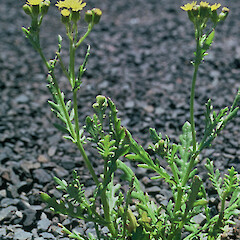Senecio pokohinuensis
Common name
Mokohinau groundsel
Synonyms
Senecio repangae subsp. pokohinuensis de Lange et B.G.Murray
Family
Asteraceae
Flora category
Vascular – Native
Endemic taxon
Yes
Endemic genus
No
Endemic family
No
Structural class
Herbs - Dicotyledonous composites
Chromosome number
2n = 100
Current conservation status
The conservation status of all known New Zealand vascular plant taxa at the rank of species and below were reassessed in 2017 using the New Zealand Threat Classification System (NZTCS) – more information about this can be found on the NZTCS website. This report includes a statistical summary and brief notes on changes since 2012 and replaces all previous NZTCS lists for vascular plants.
Please note, threat classifications are often suggested by authors when publications fall between NZTCS assessment periods – an interim threat classification status has not been assessed by the NZTCS panel.
- Conservation status of New Zealand indigenous vascular plants, 2017 . 2018. Peter J. de Lange, Jeremy R. Rolfe, John W. Barkla, Shannel P. Courtney, Paul D. Champion, Leon R. Perrie, Sarah M. Beadel, Kerry A. Ford, Ilse Breitwieser, Ines Schönberger, Rowan Hindmarsh-Walls, Peter B. Heenan and Kate Ladley. Department of Conservation. Source: NZTCS and licensed by DOC for reuse under the Creative Commons Attribution 4.0 International licence.
2017 | At Risk – Naturally Uncommon | Qualifiers: IE, Sp
Previous conservation statuses
2012 | At Risk – Naturally Uncommon | Qualifiers: IE, Sp
2009 | At Risk – Naturally Uncommon | Qualifiers: OL, EF, IE
2004 | Range Restricted
Distribution
Endemic to the Mokohinau Islands, in the north eastern Hauraki Gulf, North Island, New Zealand
Habitat
A species usually associated with sites of active sea bird nesting or roosting. It is often associated with the burrows of diving petrels, grey-faced petrels and storm petrels. On Pokohinu (Burgess) Island it also extends into former pasture, and is present as a weed in the remnants of the old light house settlement. In forested areas within sites of recent wind-throw it is often found as an early colonist.
Detailed description
Erect, sparingly branched annual to short-lived perennial herb 0.2-1.2 m tall, arising from a stout woody rootstock. Foliage dull glaucous green. Leaves sparsely pilose hairy on undersides only otherwise glabrous; basal leaves cuneately narrowed or shortly petiolate, broadly elliptic-oval or rhomboidal, coarsely toothed, rarely lyrate-pinnatifid. Mid cauline leaves amplexicaul, usually deeply bifid at base, narrow, ovate, elliptic, lanceolate or oblong, pinnately lobed 1-2-pinnatifid with segments lanceolate to oblong, entire or few-toothed, gradually diminishing in size up stem, becoming apetiolate. Uppermost leaves smaller, lanceolate, dentate or pinnatifid. Supplementary bracts 5-9, narrow, 2-5 mm long; lower most usually dentate; margins often slightly villous, apex villous. Capitulum cylindric; involucral bracts 12-20, narrowly lanceolate, 6-9 mm long, glabrescent, with purple-black villous apices. Ray florets 8-14, evenly spaced; ligules 3-6 mm, sulphur yellow; margin involute; apex recurved, incised 3-4 times. Disc yellow 4-5 mm diameter. Cypsela subcylindric, 2.5-3 mm long, grey, slightly narrowed at apex, covered in hairs, but hairs distinctly denser toward apices and between ribs.
Similar taxa
Senecio repangae de Lange et B.G.Murray is similar differing mainly by its dark green, heavily pilose-hairy foliage, urceolate involucrum, longer involucral bracts, and fewer (up to 9) ray florets which are involute, recurved, deeply incised, and widely and irregularly spaced (for more information see de Lange & Murray (1998) and de Lange et al. (2022)).
Flowering
Throughout the year
Flower colours
Yellow
Fruiting
Throughout the year
Propagation technique
Easy from fresh seed. Prefers full sun. Can become invasive.
Threats
A narrow range endemic confined wholly to the Mokohinau Islands group
Etymology
senecio: From the Latin senex ‘old man’ (probably referring to the bearded seeds)
pokohinuensis: Derived from “Pokohinu” which is te reo Maori for the type locality for the species, Pokohinu (Burgess Island), and possibly also the name for the island group, known as the “Mokohinau” Islands - a name regarded as a misnomer by the tangata whenua of the islands, Ngati Rehua.
Where To Buy
Not commercially available.
Attribution
Fact Sheet prepared for NZPCN by P.J. de Lange 1 November 2008. Description based on de Lange & Murray (1998).
References and further reading
de Lange, P.J.; Murray, B. G. 1998: Senecio repangae (Asteraceae): a new endemic species from the north-eastern North Island, New Zealand. New Zealand Journal of Botany 36(4): 509-519
de Lange, P.J.; Pelser, P.B.; Liew, C-S.; Marshall, A.J. 2022: Senecio pokohinuensis (Asteraceae), a new combination for an endemic species of Mokohinau Islands, Hauraki Gulf (Tikapa Moana o Hauraki), northern Te Ika a Maui / North Island, Aotearoa / New Zealand. Ukrainian Botanical Journal 79(3): 125–129. https://doi.org/10.15407/ukrbotj79.125
NZPCN Fact Sheet citation
Please cite as: de Lange, P.J. (Year at time of access): Senecio pokohinuensis Fact Sheet (content continuously updated). New Zealand Plant Conservation Network. https://www.nzpcn.org.nz/flora/species/senecio-pokohinuensis/ (Date website was queried)

